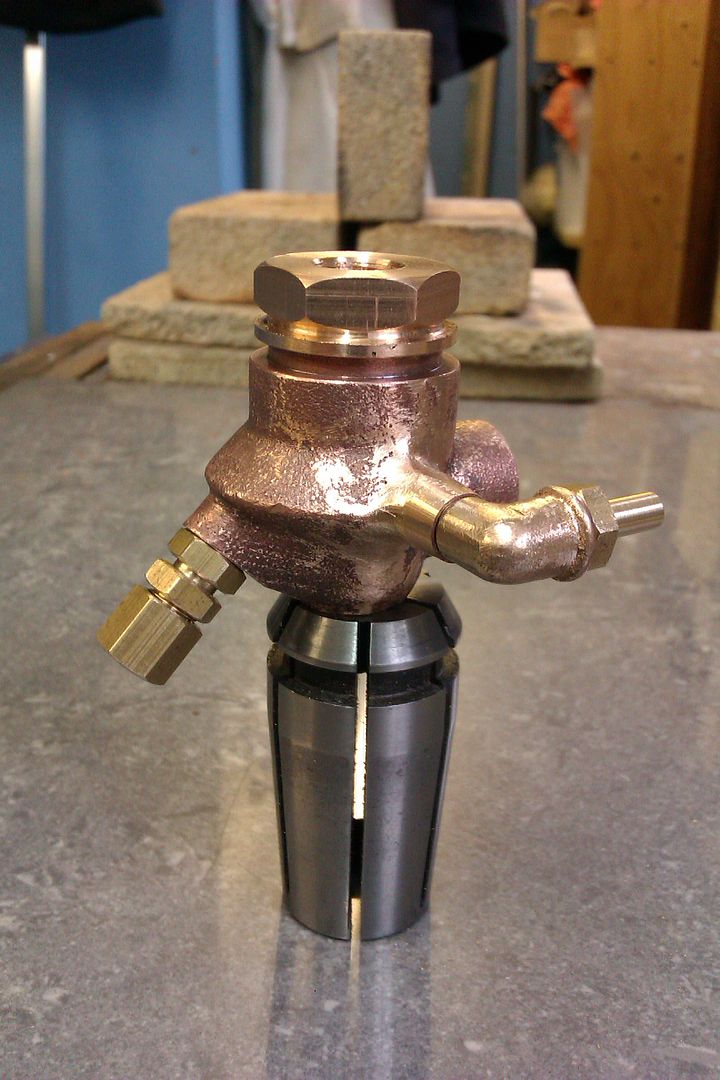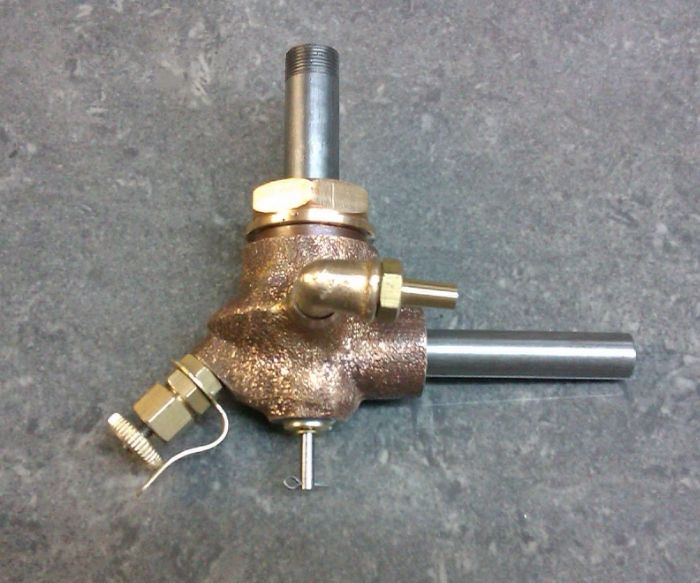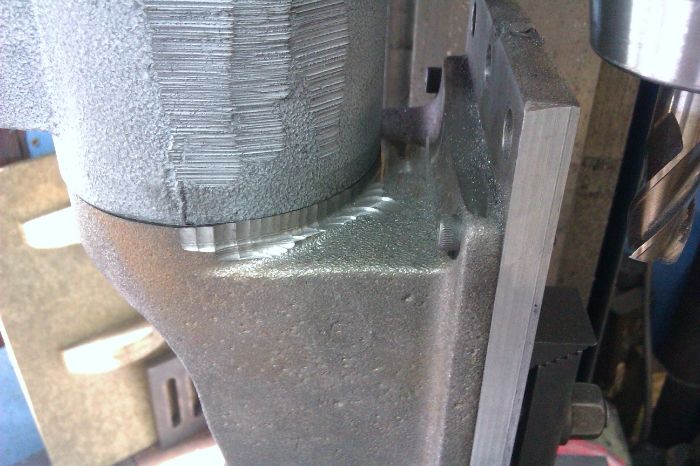Casting Preperation
| S.D.L. | 10/10/2013 21:53:34 |
| 236 forum posts 37 photos | I am just starting on some castings I have for a universal pillar tool, and wonder at what stage most model engineers clean the castings up? I have decided to go all over them with a file and emry on the non machined faces before machining as I am concerned, that I will slip and damage a face if done after machining. How do you do it? When doing things like traction engines and stationary engines do you clean the castings up all over? I find the finish very coarse on some castings but superb on others even though all sand castings.
Steve Larner |
| Andrew Johnston | 10/10/2013 22:10:44 |
7061 forum posts 719 photos | It's the first thing I do. I go over the whole casting with a wire brush to get rid of casting sand, grit and the like. Then I go over all surfaces that will be unmachined with files to remove flash and any casting imperfections. I don't bother with emery. On surfaces that will be machined I only remove flash and suchlike if needed to ensure that the casting will seat properly during machining. Regards, Andrew |
| Geoff Rogers | 10/10/2013 22:20:19 |
| 30 forum posts 4 photos | Per Andrew, except I then give the not-to-be-machined regions a coat of paint. Makes then nicer to handle and easier to clean.
regards Geoff (currently in Germany for a rail impact test) |
| Gray62 | 10/10/2013 22:38:07 |
| 1058 forum posts 16 photos |
With the castings for my UPT, I gave them a scrub up on a brass wire wheel on the bench grinder, then a couple of coats of hammerite before machining. The quality of the castings is pretty good so they didn't need a lot of cleaning up CB
|
| S.D.L. | 10/10/2013 22:43:20 |
| 236 forum posts 37 photos | Posted by Andrew Johnston on 10/10/2013 22:10:44:
It's the first thing I do. I go over the whole casting with a wire brush to get rid of casting sand, grit and the like. Then I go over all surfaces that will be unmachined with files to remove flash and any casting imperfections. I don't bother with emery. On surfaces that will be machined I only remove flash and suchlike if needed to ensure that the casting will seat properly during machining. Regards, Andrew Are you painting directly over the filed surface of adding stopper / filler on your traction engine?
Steve |
| S.D.L. | 10/10/2013 22:46:21 |
| 236 forum posts 37 photos | Posted by Geoff Rogers on 10/10/2013 22:20:19:
Per Andrew, except I then give the not-to-be-machined regions a coat of paint. Makes then nicer to handle and easier to clean regards Geoff Is the paint red-oxide type primer? Does it take topcoat ok after the cutting oil/ tapping fluid etc that gets on it ? |
| JasonB | 11/10/2013 07:39:44 |
25215 forum posts 3105 photos 1 articles | Like the others I fettle the castings first, removing the part lines also gives an indication of a chilled casting as the thin bits are the first to go hard. On smaller items I run a die grinder with a grinding bit over the surface to knock off the high spots. Mostly I don't paint before machining, you should not really need coolant on CI and I tap/drill it dry Unless there is a major problem with the casting I won't fill it on a live steamer like a traction engine but on some of the stationary engines then its out with the U-pol. As an example I filled this last weekend as the model used three castings where the original was one piece so there are joint lines to hide and the large amount of filler down the side is where they trimmed too much off at the foundry. |
| S.D.L. | 11/10/2013 08:36:25 |
| 236 forum posts 37 photos | Posted by JasonB on 11/10/2013 07:39:44:
Unless there is a major problem with the casting I won't fill it on a live steamer like a traction engine but on some of the stationary engines then its out with the U-pol.
Thanks for the detail, Nice illustration, much appreciated. Is U-pol a filler from the car paint factors?
Steve |
| Andrew Johnston | 12/10/2013 11:56:25 |
7061 forum posts 719 photos | Steve: I haven't actually painted anything yet on my traction engines. I'm not planning to go mad with filler before painting. For castings that are not seen, like the differential centre, they'll just get painted. For more visible castings I might use a bit of filler if there are visually intrusive defects, but I'm not intending to smother the castings in filler and then sand most of it off in order to get a smooth finish. Life is too short! Regards, Andrew |
| JasonB | 12/10/2013 12:15:28 |
25215 forum posts 3105 photos 1 articles | Halfords do U-pol, I find it sands better than P-38 |
| Stub Mandrel | 12/10/2013 13:38:03 |
4318 forum posts 291 photos 1 articles | I have to agree with Andrew. I spend effort making fabrications look like castings, and I want my castings to look cast! Neil PS> it's nothing to do with being able to blame surface finish on casting rather than painting technique (or lack of it). |
| NJH | 12/10/2013 13:46:49 |
2314 forum posts 139 photos | Hi Steve The Pillar tool is a good choice of project. I built one 30+ years ago and I use it often - with another current thread in mind it might almost be my favourite tool! You will see from my picture though that I didn't take too much trouble with "prettying up" the castings but then it was never intended to be an exhibition subject. I'm not likely to make the sensitive drill attachment either but I do have some dials to stamp for an "in progress" Stent project someday so the punch holder is in the offing. Norman |
| JasonB | 12/10/2013 13:52:05 |
25215 forum posts 3105 photos 1 articles | On softer castings I use an old Wolf engraver to reinstate the texture if its required, this Lukenheimer carb is a good example, you can see the smooth areas where its been fettled and plugs silver soldered in to fill fuel passages.
And the same thing after 5mins with the Wolf
This is the side of that engine I posted above showing where it was ground away by the foundry and where the lower casting has had to be milled away as one mating part was 3/16" smaller diameter than the other. This engine also suffered from the nasty habit of using Dymo lables to identify the patterns which are reproduced on the castings, by the time they have been ground off you loose all the sand texture
|
Please login to post a reply.
Want the latest issue of Model Engineer or Model Engineers' Workshop? Use our magazine locator links to find your nearest stockist!
Sign up to our newsletter and get a free digital issue.
You can unsubscribe at anytime. View our privacy policy at www.mortons.co.uk/privacy
- *Oct 2023: FORUM MIGRATION TIMELINE*
05/10/2023 07:57:11 - Making ER11 collet chuck
05/10/2023 07:56:24 - What did you do today? 2023
05/10/2023 07:25:01 - Orrery
05/10/2023 06:00:41 - Wera hand-tools
05/10/2023 05:47:07 - New member
05/10/2023 04:40:11 - Problems with external pot on at1 vfd
05/10/2023 00:06:32 - Drain plug
04/10/2023 23:36:17 - digi phase converter for 10 machines.....
04/10/2023 23:13:48 - Winter Storage Of Locomotives
04/10/2023 21:02:11 - More Latest Posts...
- View All Topics
- Reeves** - Rebuilt Royal Scot by Martin Evans
by John Broughton
£300.00 - BRITANNIA 5" GAUGE James Perrier
by Jon Seabright 1
£2,500.00 - Drill Grinder - for restoration
by Nigel Graham 2
£0.00 - WARCO WM18 MILLING MACHINE
by Alex Chudley
£1,200.00 - MYFORD SUPER 7 LATHE
by Alex Chudley
£2,000.00 - More "For Sale" Ads...
- D1-3 backplate
by Michael Horley
Price Not Specified - fixed steady for a Colchester bantam mark1 800
by George Jervis
Price Not Specified - lbsc pansy
by JACK SIDEBOTHAM
Price Not Specified - Pratt Burnerd multifit chuck key.
by Tim Riome
Price Not Specified - BANDSAW BLADE WELDER
by HUGH
Price Not Specified - More "Wanted" Ads...
Do you want to contact the Model Engineer and Model Engineers' Workshop team?
You can contact us by phone, mail or email about the magazines including becoming a contributor, submitting reader's letters or making queries about articles. You can also get in touch about this website, advertising or other general issues.
Click THIS LINK for full contact details.
For subscription issues please see THIS LINK.
Model Engineer Magazine
- Percival Marshall
- M.E. History
- LittleLEC
- M.E. Clock
ME Workshop
- An Adcock
- & Shipley
- Horizontal
- Mill
Subscribe Now
- Great savings
- Delivered to your door
Pre-order your copy!
- Delivered to your doorstep!
- Free UK delivery!

















 Register
Register Log-in
Log-in


